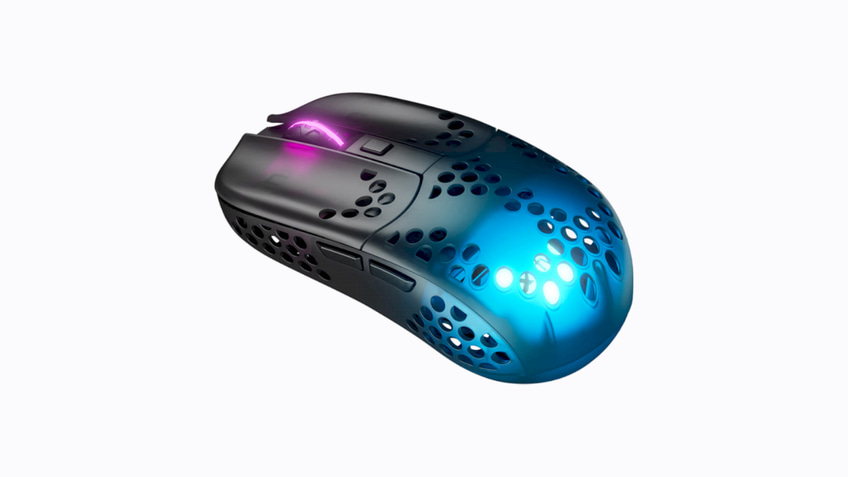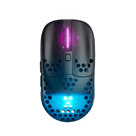Introduction
When Xtrfy released the MZ1 around a year ago, the mouse was received with a lot of praise. Made in collaboration with Zy “RocketJumpNinja” Rykoa, the small mouse offered a completely unique shape that went pretty far away from what we normally see with mice at that size. The fact that the MZ1 brought that new take on mouse shapes to the market in a package with no large noteworthy flaws made it somewhat of a cult hit, and as such it’s no surprise that Xtrfy have decided to give it their wireless treatment.
The fact that it went wireless isn’t the only change, however. There’s a new sensor inside, and Xtrfy have also introduced a swappable back shell design like they did on their other mice, as well as the ability to shift around the battery so that you can get your desired weight balance.
Is this wireless version the ultimate weapon for aim Gods? Is it a worthy upgrade over the wired version? We’ve send a unit over to our reviewer to answer all of your questions. Read our full Xtrfy MZ1 Wireless review in order to find out everything you want to know!
At A Glance
Xtrfy MZ1 Wireless
Used by 1 player ()The wireless connection is flawless, the sensor is flawless, the buttons feel great, the feet are smooth and speedy, the scroll wheel has no issues, … With no glaring flaws and a very interesting take on shell design, the Xtrfy MZ1 Wireless is an interesting, yet niche option in the always growing world of quality wireless gaming mice.
Pros
- Choice of two included back shells to maximize comfort and grip
- Unique shape
- Flawless wireless performance
- Fast and smooth stock feet
Cons
- Customizable battery location feels a bit gimmicky
- Looks a bit goofy
Specs
| Sensor | PMW 3370 |
|---|---|
| DPI | 400, 800, 1200, 1600, 3200, 4000, 7200, 16000 |
| Polling Rate | 125 / 500 / 1000 Hz |
| Button Switches | Kailh GM 8.0 |
| Button Force | 68g |
| Connection | Wireless |
| Shape | Ambidextrous |
| Length | 11.12cm |
| Height | 3.65cm |
| Weight | 62g |
| Width | 5.25cm |
First Impressions
Upon unboxing the MZ1 Wireless I immediately noticed that not a lot had changed in the looks department, and I think that that’s a bit of a shame. The community as a whole seems to be well past cheese grater designs in mice, and while I personally don’t mind the holes (I do prefer a solid shell these days, but I have no issues using a mouse with holes in it) I have to say that I think this mouse would look (and feel, in case you’re someone who dislikes the feeling of holes under your fingers) a whole lot better with a solid shell.
I am of course aware of RocketJumpNinja’s (I will abbreviate that as RJN in this review at some points) ‘performance over aesthetics’ ideas, so if these holes shave even 1 gram off of the weight they already have their reason to exist if you look at the mouse in that context, but then why does it have RGB? RGB is utterly pointless if we’re talking purely from an esports performance context.
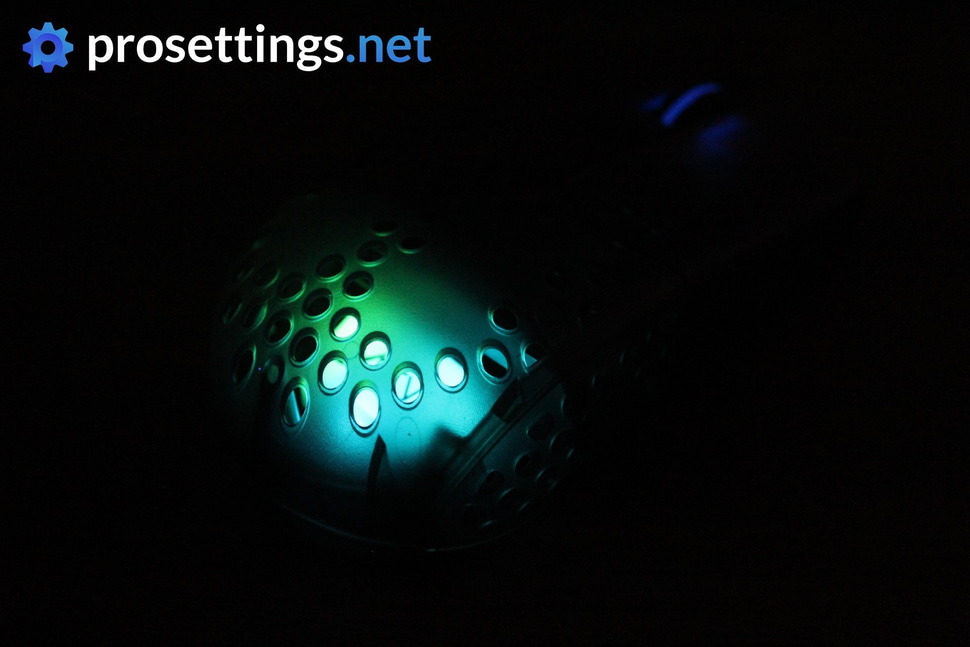
As you may or may not know, the looks of a gaming mouse don’t influence my opinion on the product, but since this is the ‘first impressions’ section I will say that the MZ1 could definitely do with a makeover if you’re asking me. The translucent smoky black shell also reminds me of a toy from the late 90’s, and while I’m not against some retro vibes, the MZ1 Wireless still looks every bit as goofy as its wired predecessor. Again: the looks don’t matter one bit, but just imagine how sleek this mouse would look with a matte white finish and no holes, for example.
Moving on to more important things, then: the shape. That the MZ1 has a unique shape is something that’s been known since the wired version came out, but this wireless version now (just like all recent Xtrfy mice) comes with a swappable back shell. I will speak more about these shells further down in the review, but that’s definitely good news for people who had issues with the rather high hump on the original MZ1.
Aside from the swappable shells, I don’t immediately notice any changes between this wireless version and the wired edition.
Packaging
Xtrfy is a company that’s playing in the top leagues when it comes to their packaging. Inside the box you will find the mouse itself (obviously) along with a USB-C charging cable, a USB receiver, an extender dongle for said receiver, a screwdriver to move the battery and swap shells, an extra back shell, a sticker, the usual documentation, and a pair of additional mouse feet.
I absolutely love this. Everything you need to get going for years and years can be found in the box. It’s especially nice to see replacement feet included in the box of a mouse that’s aimed at hardcore gamers, as those users are far more likely to care about their skates degrading, so it’s definitely nice to see that Xtrfy thinks about that with all of their releases.
Shape, Coating, and Mouse Feet
The MZ1 has been designed by Zy “RocketJumpNinja” Rykoa, and that man has some strong opinions on aiming. According to RJN, a small mouse is better for aiming, for example. I would say that it depends on the context. You can read a more detailed explanation of my thoughts on the subject in the MZ1 review (under the ‘Shape and finish’ section) but in short: for me, smaller and very light mice feel better for games where flicking and tracking are the more important aspects of aim, but I prefer larger/more filling mice for games where stability and crosshair placement is of more importance.
That being said: I firmly believe that all of this is subjective. For some people, small mice are the name of the game, while others will perform at their best with a larger (and perhaps heavier) mouse. You may not immediately notice it, but the shape isn’t perfectly symmetrical. There’s a small indentation for your thumb on the left side, for example, and that’s not there on the right side. There are also very pronounced comfort grooves (something that RJN greatly appreciates in mice) and all of this leads to a mouse that’s a lot more ‘formed’ than what you usually find on small mice, as those usually tend to go for a neutral, almost eggy shape.
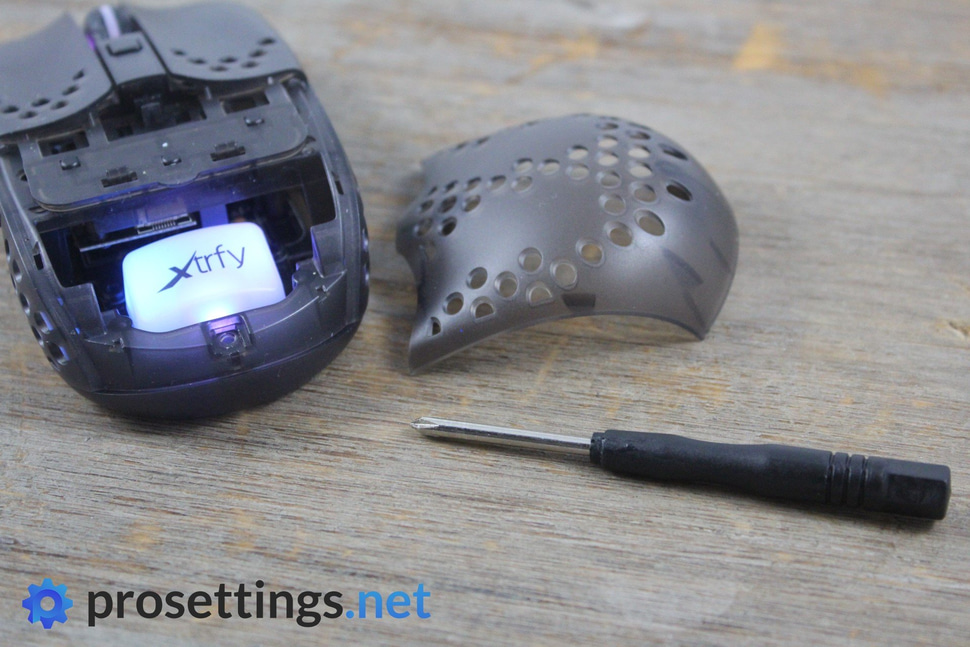
In my MZ1 review, I mentioned that holding the mouse feels almost like holding a pen: my thumb, pointer finger, and middle finger are relatively close to the surface I’m playing on and to each other, and that combined with the raised palm (due to the hump at the back of the original shell) makes for a shape that makes me hold it in a similar fashion to how I hold a pen. Again, for my complete thoughts on the original shape you can read the shape section of my review of the previous version, since nothing has changed when it comes to the shape.
What has changed is the fact that there’s now a second back shell that you can use. This one is a lot flatter and leads to a much more neutral feeling mouse, and I think that that’s good news. The back hump on the wired version felt fine to me (I like a bit of palm contact) but I know a lot of people who felt it to be very limiting in regards to how they held the mouse, so the inclusion of this much more neutral backside means that the mouse feels a lot less like a completely custom-built mouse that will only fit a very small number of people perfectly. With this second shell you get a rather flat and small mouse, which can be ideal for fingertip grippers.

The coating on the MZ1 Wireless still doesn’t feel fantastic. It’s not as grippy as it could be, though that’s not something that’s an issue since the holes do help with grip. Still, if Xtrfy ever moves to solid shells I’d like to see a change in the coating because this gloss/matte hybrid isn’t something that I personally like.
On the bottom you’ll find three small mouse feet (one long strip on top and two small feet at the bottom) and these are just fine. I am not someone who absolutely needs super slick skates so for me these are A+ and I wouldn’t swap them out at all if I were to main the MZ1 Wireless. Your mileage here may vary, but these should be fine for the vast majority of gamers.
Recommended Grip Types
This mouse obviously won’t be for palm grippers, unless you have really small hands. Thanks to the second back shell it does offer a lot more possibilities than its wired predecessor. With the original shell it’s a very sculpted mouse that feels very hit or miss: if you don’t like a small mouse with a substantial hump at the back for palm contact you’re not going to find many ways around that. The second shell makes the whole thing feel a lot more neutral though, making it perfect for (if you ask me) fingertip grippers.
In short: I can see this mouse being used by fingertip grippers as well as claw grippers (to some extent, since you’ll never get full palm contact with a mouse that’s this small unless your hands are also very small) but as always I want to add a disclaimer here: everyone is different. What works for me (or for RJN, for that matter) might not work for you. Please take these ‘use mouse X for handsize A and grip style D’ sections in reviews with a grain of salt: they’re just guidelines.
Buttons and Scroll Wheel
It seems like all gaming mice these days use Kailh GM 8.0 switches for their main buttons, and since the wired MZ1 started off on the right track by including those switches in the first version Xtrfy felt no need to make any changes here. The Kailhs actuate with a pleasing click that sounds and feels uniform across both buttons. They’re implemented in a way that makes them feel less stiff to me than most Kailh implementations, but of course these are never going to be as light as the OG G Pro Gaming Mouse era Omrons, for example. I’m fine with that, as I don’t like super light buttons, and these are definitely good enough to spam in case you need to.
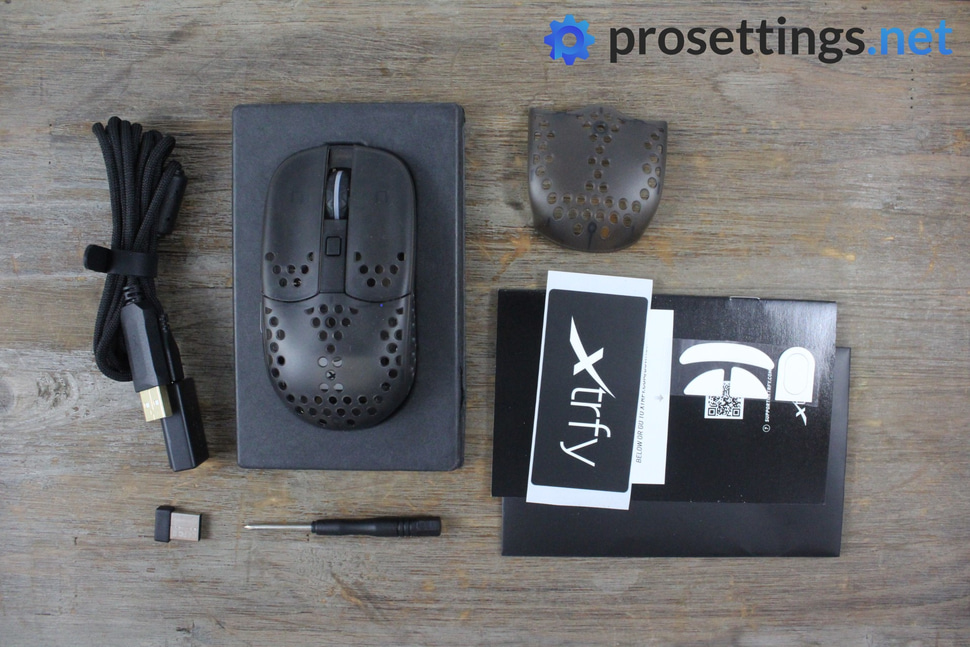
There’s pretty much no noticeable pre- or post travel on either main button, and there’s also no sideplay. I say ‘noticeable’ because it’s always possible to detect some travel (that’s just the way mouse buttons work) but it’s not noticeable in actual gaming scenarios at all on the MZ1 Wireless. These main clickers are absolutely perfect on my copy.
The side buttons aren’t as perfect. The mouse 4 button has too much pre- and post travel for my liking, making it feel a touch less responsive than what I would like it to feel. Oddly enough, mouse 5 doesn’t have this issue, so this might be a small QC issue. Both side buttons actuate with a firm and pleasant click.
The scroll wheel is almost completely silent, and clicking the wheel requires an amount of force that’s just perfect if you ask me. The only thing I would change here if it was up to me is I would make the scroll steps a touch more defined, but that’s just nitpicking.
Build Quality and Cable
In my MZ1 review, I remarked that the shell had some unpleasant creaking and flexing issues on the spot where I put my thumb, and I’m happy to report I didn’t experience those issues with the MZ1 Wireless. Of course this is something that could pop up after months of usage, but sadly I cannot test for that as I only have a limited amount of time to spend with any given product.
Of course I did do the usual ‘stress tests’: shaking the mouse doesn’t reveal any abnormal noise, and squeezing it causes little to no flex. There’s still creaking, though. Whenever I put pressure on the shell it tends to creak (no matter where I apply this pressure). This isn’t something that annoys me enough to call it an issue, but it is of course not great either. Again we circle around to a point I made earlier on in the review: if this is indeed a performance-focused product, then why not cut the RGB and use those weight savings to focus on a more solid shell?
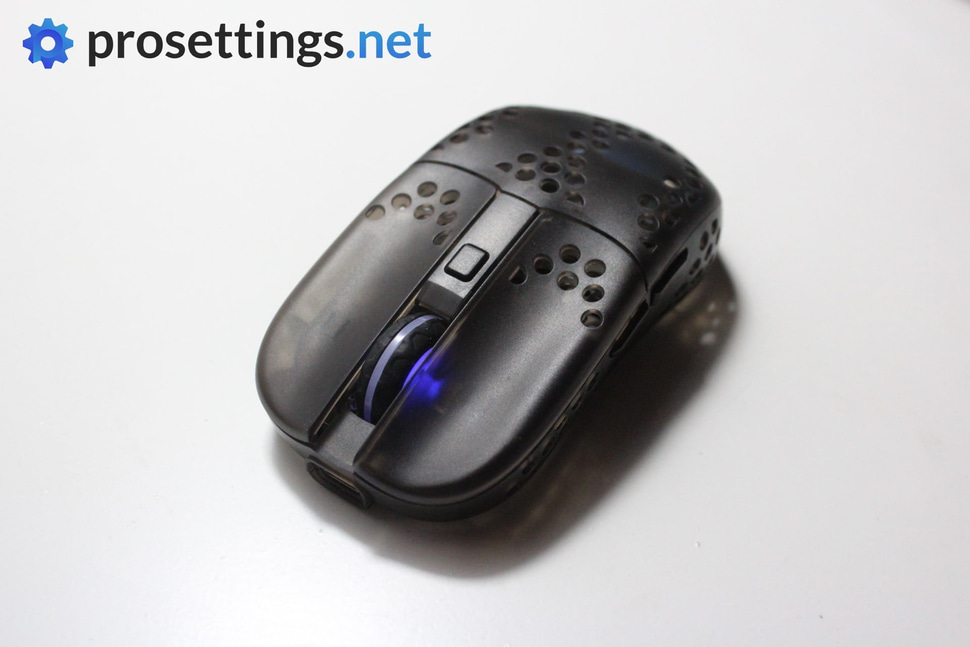
I might be a little critical here, I realize that. The creaking doesn’t influence my gameplay (and the problem is less exaggerated than it was on my MZ1 wired test copy) but it’s odd that out of all the Xtrfy mice I tested this MZ1 line of mice consistently performs the worst in the ‘creaking test’. Again: not a gameplay issue, but just a touch disappointing and, depending on your tolerance, annoying.
Sensor and Everyday Performance
The Xtrfy MZ1 Wireless uses the 3370 sensor instead of the 3389 that was found in the wired version. Both of those sensors are absolutely flawless, and just like in the wired version the sensor has been implemented perfectly here. It performs without any hiccups and doesn’t spin out, and Xtrfy’s wireless performance has been shown to be perfectly reliable in the past as well.

As all of Xtrfy’s mice, this one is plug and play. There’s no software for you to download, which means that macro makers and people who play at irregular DPI settings will either need to adjust or skip this one altogether. A feature that debuted with the MZ1 and has now found its way to all of the brand’s mice is the multifunctional top button. You can slide the selection slider on the bottom of the mouse all the way to the right and then the button behind the scroll wheel will act as the Page Down button, meaning that you’re not stuck with a useless (unless you’re one of the few people who swap DPIs when gaming) DPI button. It’s a great idea if you ask me.
Also on the bottom there are two screws that allow you to loosen and subsequently change the battery’s location. Just like on other Xtrfy mice with this feature I find this to be a tad gimmicky. It doesn’t make a huge difference for me personally, so while I appreciate the idea I do feel like this feature needs more work.
Conclusion
In my review of the wired MZ1 I said that it ticks pretty much all boxes, except for the ‘wireless connection’ box. That has now been fixed. Xtrfy added the wireless functionality without messing anything up about what made the original such a nice product, so of course this also gets an easy Staff’s Choice recommendation.
The MZ1 Wireless is a very unique mouse with a very unique shape that’s made much more accessible thanks to the inclusion of a more neutral back shell. If you’re looking for a small wireless mouse that isn’t some variation on ye olde ‘egg mouse’ design with a very neutral shape and sides then you can always take a look at this one. It obviously won’t be for everyone, but it doesn’t have to be. Not every mouse needs to go for a ‘one shape fits all’ type of design, and the MZ1 is a fantastic option for those who want to go for something more sculpted.
If you like what you’re reading and seeing about the shape then there shouldn’t be anything holding you back from trying this one out. The wireless connection is flawless, the sensor is flawless, the buttons feel great, the feet are smooth and speedy, the scroll wheel has no issues, … With no glaring flaws and a very interesting take on shell design, the Xtrfy MZ1 Wireless is an interesting, yet niche option in the always growing world of quality wireless gaming mice.
This product was received for free from the manufacturer and given to our reviewer to test and review. Brands and manufacturers have no editorial control over our reviews. For more information, check out our review FAQ.


